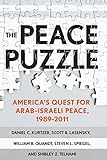The Peace Puzzle : America's Quest for Arab-Israeli Peace, 1989–2011 / Steven L. Spiegel, William B. Quandt, Scott B. Lasensky, Shibley Telhami, Daniel C. Kurtzer.
Material type: TextPublisher: Ithaca, NY : Cornell University Press, [2012]Copyright date: ©2017Description: 1 online resource (352 p.) : 2 mapsContent type:
TextPublisher: Ithaca, NY : Cornell University Press, [2012]Copyright date: ©2017Description: 1 online resource (352 p.) : 2 mapsContent type: - 9780801465864
- Arab-Israeli conflict -- Diplomatic history -- 1993-
- Arab-Israeli conflict -- Peace -- 1993-
- Arab-Israeli conflict -- 1993- -- Diplomatic history
- Arab-Israeli conflict -- 1993- -- Peace
- History
- Middle East Studies
- Political Science & Political History
- HISTORY / Middle East / Israel & Palestine
- Arab-Israeli conflict, peace negotiations, American diplomacy, U.S. politics, United States Institute of Peace, Middle East peace, American political involvement in the Middle East, U.S. administrations of the post–Cold War period
- 956.05/4 23/eng/20230216
- online - DeGruyter
| Item type | Current library | Call number | URL | Status | Notes | Barcode | |
|---|---|---|---|---|---|---|---|
 eBook
eBook
|
Biblioteca "Angelicum" Pont. Univ. S.Tommaso d'Aquino Nuvola online | online - DeGruyter (Browse shelf(Opens below)) | Online access | Not for loan (Accesso limitato) | Accesso per gli utenti autorizzati / Access for authorized users | (dgr)9780801465864 |
Frontmatter -- Contents -- Preface -- Introduction: The Decline of American Mideast Diplomacy -- 1. Opportunities Created, Opportunities Lost: Negotiations at Oslo and Madrid -- 2. Within Reach: Israeli- Syrian Negotiations of the 1990s -- 3. The Collapse of the Israeli- Palestinian Negotiations -- 4. George W. Bush Reshapes America’s Role -- 5. The Annapolis Denouement -- 6. Obama: An Early Assessment -- Epilogue: Lessons Learned and Unlearned -- Notes -- Index
restricted access online access with authorization star
http://purl.org/coar/access_right/c_16ec
Each phase of Arab-Israeli peacemaking has been inordinately difficult in its own right, and every critical juncture and decision point in the long process has been shaped by U.S. politics and the U.S. leaders of the moment. The Peace Puzzle tracks the American determination to articulate policy, develop strategy and tactics, and see through negotiations to agreements on an issue that has been of singular importance to U.S. interests for more than forty years. In 2006, the authors of The Peace Puzzle formed the Study Group on Arab-Israeli Peacemaking, a project supported by the United States Institute of Peace, to develop a set of "best practices" for American diplomacy. The Study Group conducted in-depth interviews with more than 120 policymakers, diplomats, academics, and civil society figures and developed performance assessments of the various U.S. administrations of the post–Cold War period. This book, an objective account of the role of the United States in attempting to achieve a lasting Arab–Israeli peace, is informed by the authors’ access to key individuals and official archives.
Mode of access: Internet via World Wide Web.
In English.
Description based on online resource; title from PDF title page (publisher's Web site, viewed 26. Apr 2024)


